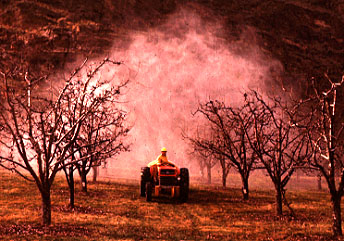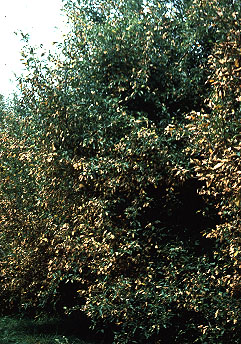
The combination of disc and swirl sizes is critical to determining the output of the sprayer. Different combinations produce droplets of varying size. Small droplets have greater surface area and evaporation may be a problem. Therefore such combinations are not used on tall trees, or in upper parts of the spray pattern, because droplets may never contact the target surface. Large droplets carry farther. Treating upper parts of the tree is generally more difficult than treating the lower parts, especially in older, larger trees. The following illustration carries two lessons: (1) ensure that calibration will allow treatment of upper parts of the canopy, and (2) do not put phytotoxic materials in an airblast sprayer tank!

Nozzle parts are produced of several materials. The least expensive is brass; brass fittings are often supplied with the sprayer. These fittings are relatively soft and wear out the fastest. Other, harder materials include ceramic and carbide steel. Although these are more expensive, they are more economical because of increased durability.
C. Dilute sprays versus concentrate,
low-volume sprays: Sprays are often applied at a
recommended gallons per acre, read from the pesticide label.
This is often referred to as dilute spraying. In order to reduce
spray time, fuel, and water use, the recommended amount of
pesticide is often applied in a reduced volume of water. This is
referred to as concentrate or low-volume spraying. A spray may
be described using multiplication factor of the mix used, e.g. a
3X spray. There are some advantages associated with concentrate
spraying (mentioned above); there are disadvantages as well,
that increase in severity with the degree of concentration.
Droplet size tends to become smaller with highly concentrated
sprays, so evaporation rate increases. Any other error factor
(such as wind speed, etc) may become more important.
tree volume (ft3) = pi r2 h,
where r is the radius of the tree and h is tree height. For example, for trees 12 ft in diameter and 15 feet tall, the tree volume will be (3.14)(6 ft)2(15 ft) = 1,696 ft3.
The air capacity may now be calculated, using the formula:
air capacity (ft3/min) = [speed (ft/min)/tree spacing (ft)] X tree volume (ft3) X 2 sides)
The speed is usually described in MPH; 1 MPH is equivalent to 88 ft/min. If the above trees are planted to a 25 by 25 foot spacing, and the sprayer will be driven at a speed of 2.5 MPH, then the air capacity will be:
air capacity (ft3/min) = [(2.5 X 88 ft/min)/25 ft] X 1,696 ft3) X 2 = 29,850 ft3/min
(a) Distance between rows,
(b) Tree height X width (ft2)
After these values are found on the axes of the graph, the desired value for gallons per acre are read. Furthermore, since less spray mix is wasted by runoff from the sprayed foliage, a reduced amount of pesticide per acre may be used, also determined from the graph. In our example orchard, the distance between rows is 24 ft. Tree size is 12 ft X 15 ft - 180 ft2. A dilute spray for this block would require 230 GPA.
New Jersey has posted information on tree row volume as well. New Zealand is also using the tree row volume method.
Determining Gallons/Minute (GPM): Once desired GPA is known, the output rate, or gallons per minute (GPM), must be calculated. The equation for this is:
GPM = (GPA X MPH X tree spacing X 2 sides) / 1000
In our example orchard, with a tree spacing of 16 ft within a row, and assuming a sprayer speed of 2 mph, this equates to:
GPM = (230 X 2 X 16 X 2 sides) / 1000 = 14.72 GPM
(Note the effect of travel speed - New Jersey Link)
An airblast sprayer has two manifolds, one on each side. Divide the calculated figure by 2 to determine to allocation of nozzle combinations on a manifold. (GPM per side = 7.36)
With the distributional pattern of output of 50% in the top third, 35% in the middle third and 15% in the bottom third, the following outputs should be allowed in the respective thirds: 3.68, 2.58, and 1.10. Some discretion may be required, depending on the number of nozzles on the manifold, and output values for specific disc/swirl combinations.
The following are output values (GPM) for a selection of nozzle settings at 200 psi:
.................................Disc size......................
| Swirl size | D2 | D3 | D4 | D5 | D6 | D7 | D8 | |
| 56 | 0.55 | 0.75 | 1.23 | 1.69 | 2.46 | 3.40 | 4.32 | |
| 25 | 0.34 | 0.40 | 0.62 | 0.75 | 0.97 | 1.18 | 1.36 |
For the 8 nozzles on the manifold, a suitable
distribution would be:
| Nozzle | 1 | 2 | 3 | 4 | 5 | 6 | 7 | 8 | |
| GPM | 1.69 | 1.69 | 1.23 | 1.23 | 0.40 | 0.40 | 0.34 | 0.34 | |
| Disc/Swirl | D5/56 | D5/56 | D4/56 | D4/56 | D3/25 | D3/25 | D2/25 | D2/25 |
The calculated output was 7.36 GPM, comparable with the 7.32 GPM obtained.
Checking the calibration: The calibration should be checked both immediately following renozzling the sprayer, as well as periodically during the season. Immediately after adjusting, put a measured volume of water in the sprayer and determine the time trequired to spray out the water. Compare this with your calculated gallons per minute value.
Spray a known area of orchard (with known trees per acre calculated from tree spacing). How much water was required to spray this area?
To enable checking the calibration during the season, note where the sprayer runs out in the first spray after calibrating the sprayer. Mark this area. As the season progresses, note how soon the sprayer runs out. When the sprayer runs out significantly earlier than when freshly calibrated (about 10%?), it is time to recalibrate. The nozzles have become worn and output has consequently increased.
See also the New England recommendations for sprayer calibration, with comments on concentrate sprays, adjuvants, and alternate row sprays, and Penn State and New Jersey comments.
| Virginia Fruit Homepage | Pesticide Usage Page |
|---|